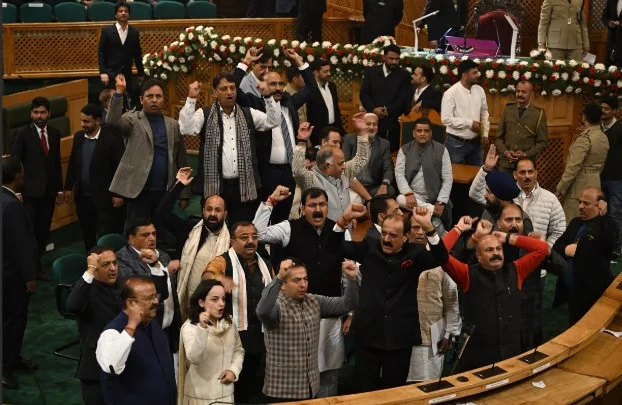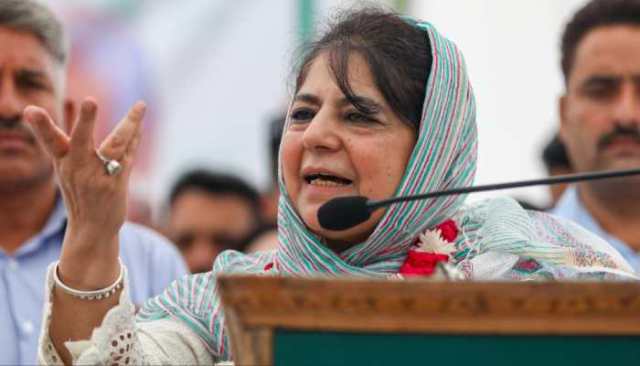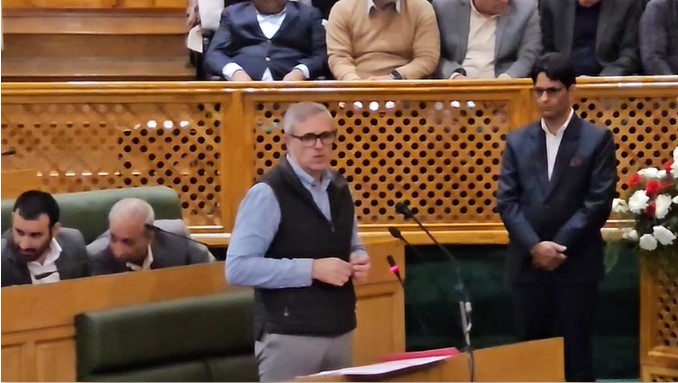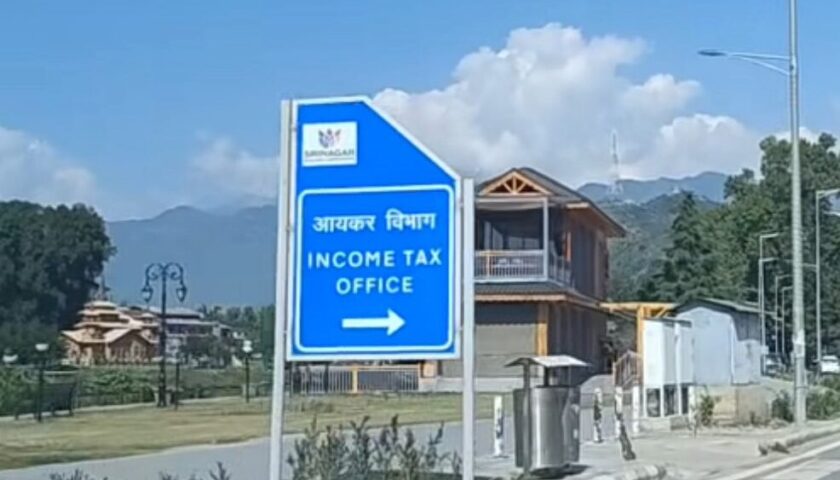During the Jammu & Kashmir Assembly’s autumn session on October 30, 2025, Speaker Abdul Rahim Rather disallowed an adjournment motion on flood rehabilitation, prompting BJP MLAs to stage a walkout in protest.
By: Javid Amin | 30 October 2025
On October 30, 2025, during the autumn session of the Jammu & Kashmir Legislative Assembly in Srinagar, tensions mounted sharply when the Speaker, Abdul Rahim Rather, declined to admit an adjournment motion by BJP MLAs pressing for a discussion on the August floods that hit the Jammu region. The BJP legislators, feeling their pleas had been ignored, staged a dramatic walkout—underscoring how disaster response, institutional procedure and political blame are intertwining in the Union Territory of J&K.
This article unpacks what happened in the Assembly, the backdrop of the floods, how the debate unfolded, the political and governance implications, and why it matters for the future of accountability in J&K.
What Happened in the Assembly
Demand for an Adjournment Motion
At the opening of the session that day, BJP MLAs rose to press for a half-hour discussion on the flood damage in the Jammu region, focusing on rehabilitation efforts and alleged government inaction. They argued that the devastation from mid-August’s heavy rainfall (houses, roads, agriculture) required immediate legislative attention.
Disallowing the Motion
Speaker Rather informed the House that the adjournment motion had been rejected under House rules (Rule 58(12) was cited) because the topic had been flagged earlier in the session and could not be admitted again at the same sitting. He suggested the issue could be taken up after Question Hour rather than via the adjournment motion.
Protest, Chaos and Walkout
Unmoved, the BJP MLAs continued to stand, shouted slogans, and demanded immediate debate. Some climbed into the Well of the House; at least three were marshalled out when the disruption persisted. The Economic Times+1 The Deputy Chief Minister and ruling benches retaliated with accusations of drama and disruption, intensifying the showdown. Finally, after Question Hour concluded, the BJP MLAs staged a walkout in protest.
Aftermath in the House
While the Question Hour proceeded, the mood in the Assembly remained charged. The Leader of Opposition (LoP) Sunil Sharma said the House had made a mockery of itself by not addressing the flood-victims’ issue. Hindustan Times+1 Meanwhile, the government side pointed out that procedural rules had been followed and accused BJP of wasting time. The House eventually moved on, but with deep rifts visible.
Flood Impact & Why the Debate Matters
Floods in August 2025
Parts of the Jammu division were hit by heavy rainfall in August 2025, triggering flash-flooding, landslides, damage to infrastructure (roads, bridges), loss of homes and disruption to agriculture and livelihoods. Though detailed official numbers are still emerging, several reports suggest large-scale destruction in vulnerable hilly districts.
Rehabilitation and Response Issues
According to BJP MLAs and local media, key concerns include:
-
Delay or absence of adequate relief and compensation for flood-victims.
-
Infrastructure repair lagging behind (roads, embankments).
-
Poor transparency on allocation of funds and actual work done in affected regions.
-
The perception that the government is treating the floods as ad-hoc rather than part of a systemic resilience challenge.
For constituents, especially in Jammu’s rural and hilly areas, the failure to secure rapid relief and rehabilitation erodes trust—not just in local administration, but the larger governance machinery.
Why Immediate Discussion Was Called For
In legislative democracies, disasters demand both operational action (relief, reconstruction) and political oversight (accountability, transparency). By seeking an adjournment motion, the BJP MLAs aimed to compel the House to:
-
Hold the government publicly answerable for flood relief and infrastructure repair.
-
Enable legislators from affected regions to voice on-the-ground concerns, raise delays, propose solutions.
-
Create a time-bound framework for restitution and monitoring.
The refusal to admit the motion turned the focus from the floods to procedure and power dynamics—raising questions over whether relief is being subordinated to politics.
Political & Governance Implications
Institutional Procedure vs Public Expectation
The Speaker’s refusal to allow the adjournment motion reflects how legislative procedure can become a flashpoint. On one hand, the House must safeguard rules (e.g., to avoid repeat motions on same subject) and manage agenda. On the other hand, the public expects that urgent issues—especially major disasters—be discussed promptly.
When process overrides urgency, the risk is that public sentiment turns sharply against institutions: “We asked for relief, got procedural talk instead.” That is evidently the mood conveyed by the walking-out MLAs.
Opposition Claim: Government Unconcerned
The BJP MLAs accused the government of being “unconcerned”, slow to act and avoiding debate because uncomfortable questions (allegations of corruption in the Roads & Buildings Department) were floating.
They demanded resignation of Chief Minister Omar Abdullah and an apology for “unfulfilled promises”.
Government’s Defence & Political Retort
The government side argued that the Speaker had offered to hold discussion after Question Hour, that rules were followed, and that BJP’s protest was more about theatrics than substance.
Ruling party MLAs defended that relief work was ongoing and accused the BJP of mis-leading people for political gain.
Deeper Implications for J&K Governance
-
Flood resilience as governance test: J&K’s geography makes disasters recurrent. Effective legislative oversight and executive delivery on such events become signature tests of governance quality.
-
Public trust: In flood-affected areas, residents expect the Assembly and government to act visibly and decisively. When political games dominate, trust erodes further.
-
Inter-regional politics: The Jammu region (which bore the brunt of the August floods) may feel that attention is less from the Centre/UT government. The walkout underscores region-wise fault-lines within J&K.
-
Legislative relevance: If MLAs and parties feel they cannot bring urgent issues into the House, they may resort to protests or outsider strategies, weakening regular legislative channels.
Why the Speaker’s Decision Triggered Such a Response
Adjournment Motion: A Special Tool
An adjournment motion is a tool for urgent discussion in the House on a matter of public importance. When it is rejected, especially in a disaster‐context, it signals either that the matter will be handled later or that the presiding officer finds procedural grounds to decline. In this case, the Speaker cited rule and prior coverage of the topic.
Floods–Victims Link: Emotional and Concrete
When people have lost homes and farms, the demand isn’t just symbolic: it’s for accountability, timelines, compensation, rebuilding. The refusal to allow immediate debate signaled to many that the House was ignoring their plight, thereby triggering strong reaction.
Symbolism of Walkout
A legislative walkout is a dramatic measure: it signals that a group believes that remaining in the house legitimises a flawed process. The BJP MLAs chose it to show that they would not be complicit in what they characterised as a “cover-up” or neglect of flood victims.
Procedural Contention Becomes Political Symbol
While the Speaker may view the issue as one of House management, for opposition it becomes evidence of political avoidance. The disruption in the House shifts media focus from flood relief to institutional stalemate—delegitimising both sides if not handled carefully.
What Needs to Happen Now – For Relief, Accountability & Trust
Immediate Action Required
-
Transparent flood‐damage assessment: The UT government needs to publish detailed data on affected households, infrastructure loss, agriculture damage in Jammu region.
-
Relief & compensation timeline: Clear deadlines for payout, rebuilding homes, restoring roads. Victims must see visible action not just announcements.
-
Special assembly discussion: Even if the adjournment motion was rejected, the House should schedule a dedicated debate, allow representation of affected MLAs, and publish minutes of discussion and action taken.
-
Independent audit/oversight: Given allegations of irregularities in road-building and rehabilitation, an independent body (UT ombudsman or audit wing) should monitor and report progress.
Legislative & Institutional Reforms
-
Better scheduling mechanisms: The Speaker and Government must develop protocols for handling disaster‐issues in the House—ensuring such matters don’t get squeezed out by routine agenda.
-
Enhanced regional representation: MLAs from disaster‐zones should get priority to raise issues and follow through until resolved.
-
Public grievance portal: This would allow flood-victims to track relief status via UID, reducing political intermediation and leakages.
-
Post-disaster legislative committee: A committee comprising MLAs across parties, experts and officials could monitor rehabilitation progress and report to the House each quarter.
Political Accountability & Communication
-
Government responsiveness: Rather than react defensively, the UT administration must engage seriously with opposition concerns, invite joint oversight and share data proactively.
-
Opposition constructive role: The BJP MLAs’ protest is legitimate in raising concerns, but they must also propose actionable follow-up rather than purely symbolic confrontation.
-
Media and public messaging: Flood victims watch both policy action and political discourse. A narrative that centres victims rather than blame games will help restore trust.
Broader Reflections: Disaster Response, Democracy & Governance
Disaster Politics = Governance Stress-Test
Natural disasters expose governance gaps: in infrastructure resilience, early warning systems, funding flows, inter-department coordination (PWD, Revenue, Agriculture). When political institutions like the legislative assembly become paralysed over procedural disputes, the real victims (flood-affected people) lose.
Democracy Needs Both Process and Purpose
Rules matter in legislative bodies—they prevent chaos and protect minority rights. But when process becomes a barrier to urgent debate, democracy suffers. The J&K episode shows the need for flexibility in exceptional circumstances without undermining institutional integrity.
Credibility of Institutions
If the Assembly is seen as unable or unwilling to discuss major disasters timely, public trust erodes—not just in one party or one session, but in the institution itself. Given J&K’s broader governance challenges (conflict legacy, terrain difficulties, resource constraints), such trust deficits are amplified.
Federal and Regional Dynamics
J&K bears additional layers: Union Territory status, regional (Jammu vs Kashmir) divisions, terrain vulnerability, youth unemployment, institutional transition. The July/August floods and the Assembly row show how disaster-policy intersects with regional sentiment and political accountability.
Bottom-Line
The October 30 walkout in the Jammu & Kashmir Legislative Assembly is more than a flashpoint in legislative procedure—it is a mirror to deeper strains in disaster management, institutional responsiveness and political accountability in the Union Territory.
When the Speaker disallowed the adjournment motion on flood-rehabilitation, the move triggered anger not just because of House rules but because many residents still await relief, many MLAs feel unheard, and the Assembly’s agenda seemed out of sync with ground realities. The BJP’s walkout symbolised that gap between victims’ lived experience and legislative process.
Now, the real test begins: Will the UT government convert rhetoric into visible results for flood-victims? Will the Assembly make room for urgent debates and region-sensitive oversight? Will politics shift from adversarial scenes in the House to collaborative action for people in distress?
For the flood-affected families of Jammu division, the answer cannot wait. They are watching beyond the walkouts and resolutions—they expect homes rebuilt, roads restored, agriculture compensated, and trust in their representatives reaffirmed.




